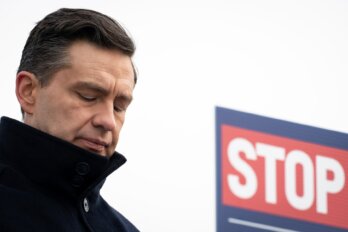Seasoned political observers will tell you that their circles—relatives, friends, colleagues—can often double as informal focus groups. By talking politics with real people, and not just those with their noses pressed against the glass, you can sometimes detect early signs of trends, however noisy they may be in a world where media cycles constantly overlap.
In a column I wrote for L’actualité at the start of this federal campaign, I noted that several indicators pointed to rising support for Mark Carney’s Liberals in Quebec. The province has historically been a pivotal player in Canadian federal elections, often determining who wins, because of the seats it holds in Parliament. Multiple polls published since have all confirmed my impression of the threat a Liberal surge poses to the sovereigntist Bloc Québécois, once poised to dominate. But the numbers have now gone berserk: the Liberals are riding a red wave, while the Bloc is sinking fast.
The reactions to the column from my sovereigntist acquaintances lingered with me. This group seemed particularly uneasy about the political context around which the Bloc campaign was unfolding. One argument stood out. Quebec cannot possibly become a sovereign nation if Canada cannot stay a sovereign nation.
It’s an old and oft-used federalist argument since the early days of the sovereignty movement: economically, Quebec can never survive on its own. This argument has been debated (and debunked) many times over the past decades. However, this was not what I was hearing from traditionally sovereigntist voters. Instead, there was a sense that if Trump’s United States enters an era of expansionism and imperialism on this continent—as the president’s current policies suggest—then the Quebec nation could never become sovereign.
Whether this would be enough to support a federalist party in this election is hard to say. But it wouldn’t be hard to understand why many “soft nationalist” Quebecers might this time around.
I thought about this a lot last week as I gazed at the growing chasm between the Liberals and the Bloc in the polls.
There is no need to beat around the bush: the Bloc finds itself in an increasingly difficult position as voters appear to prioritize federal leadership on issues like US relations over Quebec-focused messaging. The chart below presents some of the most recent federal polls in Quebec, from firms active since the start of the campaign. While the Angus Reid Institute gives the Liberals a seven-point lead in the province, all other pollsters give them a lead of eleven points or more. Many firms—namely, Léger, Abacus Data, Pollara Strategic Insights, EKOS—even place the Bloc in a statistical tie with the Conservatives in a tight battle for a distant second place. (See the full list of federal polls in Quebec here.)
The only Quebec-based pollster in the group—Léger—produced some of the worst numbers for the Bloc: 23 percent in Quebec, tied with the Conservatives and twenty points behind the Liberals.
Add the question of preferred leadership to the Liberals’ growing list of favourable indicators. Which party leader would make the best Prime Minister of Canada? From coast to coast, Léger’s latest poll measured 37 percent support for Carney, against 28 percent for Conservative leader Pierre Poilievre—a statistically significant nine-point lead. But in Quebec, the numbers show 38 percent for Carney and 18 percent for Poilievre. The daily tracker from Nanos Research showed even starker numbers: when asked to rank party leaders, more than 50 percent of Quebec respondents chose Carney as their top choice.
The data points are piling up. And with numbers like those above, it’s no surprise that seat projections are furiously raising eyebrows—mine included—because we are in uncharted territory. If the Liberals were to follow through on these numbers, it would be their best performance in over forty years.
According to the April 7 federal update from 338Canada, the Liberals are projected to win an average of forty-nine seats in Quebec—more than triple the Bloc’s average of sixteen. Should such a scenario come to pass, it would mean a Bloc caucus cut in half compared to at dissolution of Parliament.
Of course, I am nowhere close to ready to make any prediction about the outcome of the election. Quebec voters have shown little loyalty to parties in recent elections, and no political formation should ever take them for granted. The election is still three weeks away, and it would be unwise to assume today’s numbers have long-term predictive value. But one of the main purposes of seat projections is to expand the imagination—to make plausible, if surprising, scenarios feel real.
Have we seen numbers like these in Quebec before?
Yes, we did. In the 2011 federal election, the Bloc won just 23 percent of the vote in Quebec—the same level of support Léger measured at the end of March. And what happened then?
That result still haunts the Bloc. On the night of May 2, 2011, the party was nearly wiped off the map, reduced to just four seats in the province—the worst result in the Bloc’s history.
We’re not there yet. But if the Bloc continues to slip below that 23 percent threshold, a cascade of presumed safe ridings could fall—and the losses for the party could be steep.
With three weeks to go, nothing is set in stone. But it will get late early for the Bloc.




